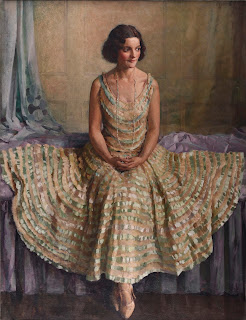Blackheath School of Art student Hugh Hopgood
It has a been a while since I have added an entry about the Blackheath School of Art and this artist was a bolt from the blue as I had never heard of Hugh Hopgood. His works can be found today in New York. Hopefully he will provide a little but of interest before I delve into the school in more detail under the leadership of John Edgar Platt as I have recently discovered that the British Library holds copies of the Blackheath Local Guide (more about these discoveries from this valuable source soon)...
Born in 1886 in Ryde on the Isle of Wight, Hugh Hopgood was
one of two children of Richard and Sarah Hopgood. Hopgood was a student at the
Blackheath School of Art and was listed as an art student in the 1911 census
(the family lived at 40 Mayhill Road Charlton).
Hopgood was seen as a student of great promise and this was
revealed in articles and exhibition reviews of the Blackheath School of Art in
the early 1900’s. Hugh received a number of awards and certificates in 1908
including: certificates for anatomy, drawing from life and machine
construction, the drawing prize for ‘time studies from life’
and the Sketch Club prize.[1]
Hopgood’s work was singled out for praise in the 1908 student’s exhibition. His
‘time studies’ were praised as were his book illustrations under the tutelage
of Max Cowper.[2] In
this discipline the author of a Kentish Mercury article felt that ‘Mr H Hopgood
with his imagination and strength has a fine future’.[3] In 1910 Hopgood achieved a large number of accolades for his
studies at the school. He could count amongst his achievements the King’s Prize
for excellence in life drawing, National Book prize for sgraffito design on a
vase, prize for works selected for competition, principal’s medal for time
studies from life, first class certificates for drawing from life and the
antique, and painting from still life and second class certificates for design
and principles of ornament. [4]
Hopgood then travelled to Egypt as a member of a party to
copy monuments in Egypt. He travelled with the renowned archaeologists Norman
and Nina Davies, returning to Tilbury Docks in 1915.[5]
He was travelling to Egypt as a part of a Metropolitan Museum of Art entourage
to record certain paintings to ensure their posterity without damage. Even back
then there was concern for the conservation of ancient paintings as their
removal would result in irreparable damage or destruction. Hopgood also
travelled to Egypt again in 1916 as manifests show that he returned to Plymouth
from Alexandria on 21 April.[6]
 |
| Hugh Hopgood, Men Preparing Fish, Tomb Puyemre, tempera on paper, 1915 (?), Rogers Fund, 1930. Source: Metropolitan Museum of Art. |
 |
| Hugh Hopgood and Nina Davies, Osiris and the Four Sons of Horus, Tomb of Nebamun and Ipuky, Thebes, tempera on paper, 1915 (?), Rogers Fund, 1930. Source: Metropolitan Museum of Art. |
The resultant works are on display in the Met in New York
today, brilliantly brightly coloured tempera images on paper. Some of his works
were collaborations with Nina Davies, one example featuring Osiris and Horus
(above) from The Tomb of Nebamun and Ipuky, Thebes. Hopgood’s early skills with
‘time studies’ had held him in good stead. The colours are quite vibrant (in
the reproductions) and I was quite surprised at how, even in the early years of
the twentieth century that artists were employed to make facsimiles of ancient
art rather than it being removed to be included in a museum collection.
 |
| Hugh Hopgood, Ceiling Fragment, Tomb of Amenemhat Surer, tempera on paper, 1915 (?), Rogers Fund, 1930. Source: Metropolitan Museum of Art. |
I have not come across much about Hopgood as an artist other
than his work creating facsimiles for the museum. He joined the RAF later in the First World War, and
electoral rolls recorded him living in the family home (1920), Chelsea (1922) and
Croydon (1965). He was married to Bessie Flora Marks, a nurse, in December 1920.
Hopgood died on 2 December 1976 in Croydon.[7]
It’s great to be able to find out about BSA students becoming artists who
worked in far off places - as he followed Nora Cundell to be one of the adventurous
ex-students of the Art School. As with all entries I will update his biography
as and when I come across more information.
[1]
Blackheath School of Art: Distribution of Prizes by M David Murray, R.A.,
Kentish Mercury, Fri 6 March, 1908, p. 2. Nora Cundell also won the Sketch Club
Prize in 1908. Hopgood’s brother Howard also achieved certificates for machine
construction and drawing in 1908.
[2]
Blackheath School of Art: Exhibition of Students’ Work, Kentish Mercury, Fri 2
October, 1908, p. 4.
[3] ibid.
[4]
Blackheath School of Art: Distribution of Prizes by the Lord Mayor and Lady
Mayoress, Kentish Mercury, Fri 11 February 1910, p. 2.
[5]
Hopgood travelled with the Davies’ on the ship Gloucestershire in 1915.
[6]
Hopgood travelled on Trafford Hall from Alexandria to Plymouth.
[7]
The probate shows that his address was 3 Park House, Park Lane, Croydon.













